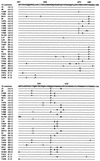Identification of hepatitis C virus (HCV) subtype 1b strains that are highly, or only weakly, associated with hepatocellular carcinoma on the basis of the secondary structure of an amino-terminal portion of the HCV NS3 protein
- PMID: 12843009
- PMCID: PMC165328
- DOI: 10.1128/JCM.41.7.2835-2841.2003
Identification of hepatitis C virus (HCV) subtype 1b strains that are highly, or only weakly, associated with hepatocellular carcinoma on the basis of the secondary structure of an amino-terminal portion of the HCV NS3 protein
Abstract
The NS3 protein of hepatitis C virus subtype 1b (HCV-1b) isolates obtained from 89 patients with hepatocellular carcinoma (HCC) and 78 patients without HCC were analyzed. On the basis of the secondary structure of the amino-terminal 120 residues of NS3, HCV-1b isolates were classified into group A, group B, and an indeterminate group, each of which was further divided into a number of subgroups, such as A1-1, A1-2, A2-1, A2-2, B1-1, B1-2, B2-1, B2-2, C-1, C-2, and C-3. HCV-1b isolates of subgroup B1-1 were found in 53 (59.6%) of 89 patients with HCC and 19 (24.4%) of 78 patients without HCC, with the difference between the two patient groups being statistically significant (P < 0.00001). Although the number of isolates was small, subgroup B2-1 was also highly associated with HCC, with all five isolates in that subgroup being found in patients with HCC (P < 0.05). On the other hand, HCV-1b isolates of subgroup A1-1 were associated only weakly with HCC; they were found in 6 (6.7%) of 89 patients with HCC and in 25 (32.1%) of 78 patients without HCC, with the difference between the two patient groups being statistically significant (P < 0.0001). The other subgroups, such as A1-2, A2-1, B1-2, C-1, C-2, and C-3, were moderately associated with HCC; their distribution patterns among patients with HCC did not differ significantly from those among patients without HCC. Taken together, our results suggest that HCV-1b isolates of subgroups B1-1 and B2-1 are highly associated with HCC and that this secondary structure analysis may be useful for predicting the relative risk of developing HCC.
Figures


Similar articles
-
Correlation between secondary structure of an amino-terminal portion of the nonstructural protein 3 (NS3) of hepatitis C virus and development of hepatocellular carcinoma.Microbiol Immunol. 2002;46(8):549-54. doi: 10.1111/j.1348-0421.2002.tb02732.x. Microbiol Immunol. 2002. PMID: 12363018
-
Risk of hepatocellular carcinoma and secondary structure of hepatitis C virus (HCV) NS3 protein amino-terminus, in patients infected with HCV subtype 1b.J Infect Dis. 2007 Oct 1;196(7):1006-9. doi: 10.1086/521309. Epub 2007 Aug 23. J Infect Dis. 2007. PMID: 17763321
-
Comparative sequence analysis of the core protein and its frameshift product, the F protein, of hepatitis C virus subtype 1b strains obtained from patients with and without hepatocellular carcinoma.J Clin Microbiol. 2002 Oct;40(10):3625-30. doi: 10.1128/JCM.40.10.3625-3630.2002. J Clin Microbiol. 2002. PMID: 12354856 Free PMC article.
-
Hepatitis C: progress and problems.Clin Microbiol Rev. 1994 Oct;7(4):505-32. doi: 10.1128/CMR.7.4.505. Clin Microbiol Rev. 1994. PMID: 7834603 Free PMC article. Review.
-
[Hepatitis C virus-induced glucose metabolic disorder].Uirusu. 2015;65(2):263-268. doi: 10.2222/jsv.65.263. Uirusu. 2015. PMID: 27760925 Review. Japanese.
Cited by
-
From viruses to cancer: exploring the role of the hepatitis C virus NS3 protein in carcinogenesis.Infect Agent Cancer. 2024 Aug 27;19(1):40. doi: 10.1186/s13027-024-00606-2. Infect Agent Cancer. 2024. PMID: 39192306 Free PMC article. Review.
-
Decreased apoptosis in advanced-stage/high-grade hepatocellular carcinoma complicating chronic hepatitis C is mediated through the downregulation of p21 ras.Chin J Cancer Res. 2013 Jun;25(3):281-8. doi: 10.3978/j.issn.1000-9604.2013.04.02. Chin J Cancer Res. 2013. PMID: 23825904 Free PMC article.
References
-
- Bruno, S., E. Silini, A. Crosignani, F. Borzio, G. Leandro, F. Bono, M. Asti, S. Rossi, A. Larghi, A. Cerino, M. Podda, and M. U. Mondelli. 1997. Hepatitis C virus genotypes and risk of hepatocellular carcinoma in cirrhosis: a prospective study. Hepatology 25:754-758. - PubMed
-
- Davidson, F., P. Simmonds, J. C. Fergason, L. M. Jarvis, B. C. Dow, E. A. C. Follet, C. R. G. Seed, T. Krusius, C. Lin, G. A. Medgyesi, H. Kiyokawa, G. Olim, G. Duraisamy, T. Cuypers, A. A. Saeed, D. Teo, J. Conradie, M. C. Kew, M. Lin, C. Nuchaprayoon, O. K. Ndimbie, and P. L. Yap. 1995. Survey of major genotypes and subtypes of hepatitis C virus using RFLP of sequences amplified from the 5′ non-coding region. J. Gen. Virol. 76:1197-1204. - PubMed
Publication types
MeSH terms
Substances
LinkOut - more resources
Full Text Sources
Other Literature Sources
Medical
Molecular Biology Databases
Miscellaneous

